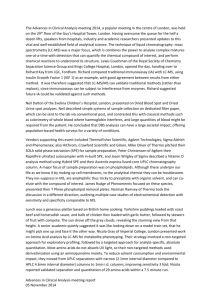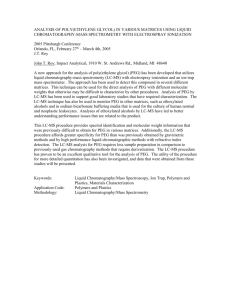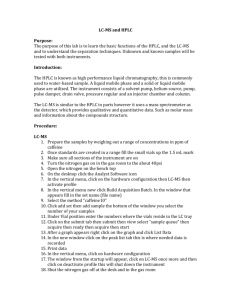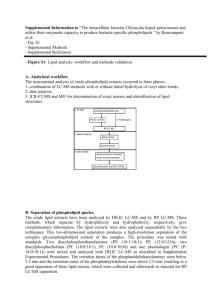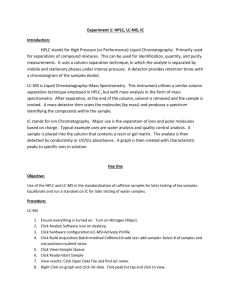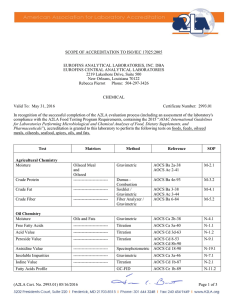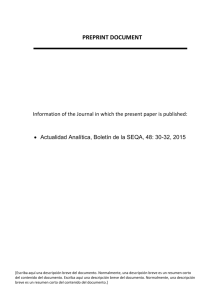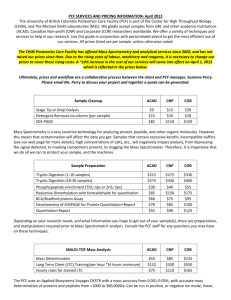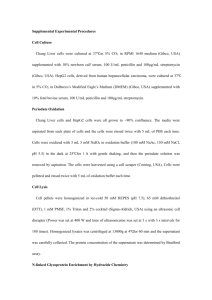Laboratory Challenges in Clinical Toxicology of Pain Management
advertisement
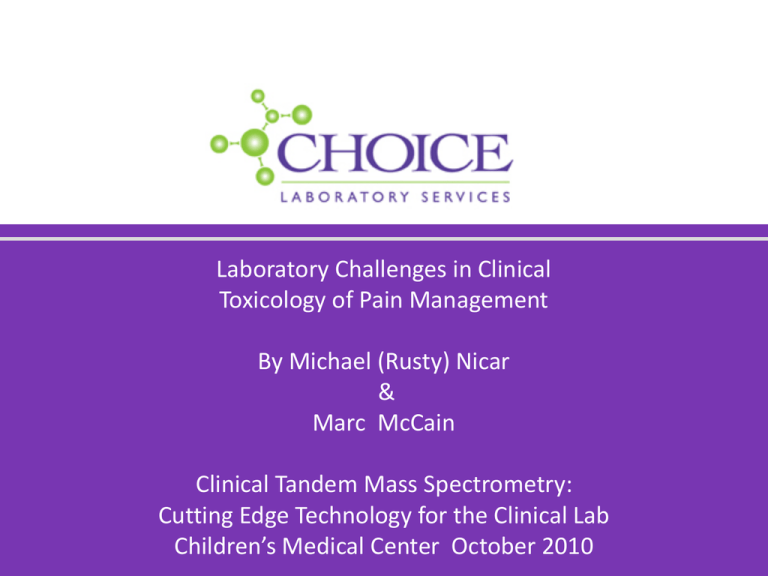
Laboratory Challenges in Clinical Toxicology of Pain Management By Michael (Rusty) Nicar & Marc McCain Clinical Tandem Mass Spectrometry: Cutting Edge Technology for the Clinical Lab Children’s Medical Center October 2010 Texas Medical Board Rules 2010 What is Chronic Pain: “a state in which pain persists beyond the natural course of an acute disease or healing of an injury.” Appropriate drug therapy: “recognized by consensus.” “A physician may require laboratory tests for drug levels upon request.” How Many Patients Have Chronic Pain? 1 out of 4 Americans have recurrent pain 1 out of 10 have pain of at least 1 yr duration Treatment of Choice for Chronic Pain CHRONIC OPIOID Rx Hydrocodone is the most prescribed drug in the USA. Others used for pain: morphine, codeine, fentanyl, oxycodone, hydromorphone, oxymorphone, meperidine, methadone. Why Do Pain Doctors Drug Test Concerns: Drug Diversion (majority of overdose deaths in W. Virginia were due to diversion of opioids, JAMA 2008 300:2613) Taking non-prescribed or illegal drugs Taking more than the prescribed dose Overdose Estimated Number of Emergency Department Visits in 2006: Opioids – 250,000 Acetaminophen – 50,000 NSAIDS – 35,000 What Medications Do Pain Patients Take What Are Patients Taking CT: Cymbalta, Lyrica, Fentanyl, Hydrocodone GG: Flexeril, Rozerem, Lortab, Allegra, Relafen TK: Duragesic, Percocet, Ambien RT: Lyrica, Norco LV: Zantac, Carisoprodol, Wellbutrin, Topamax, Ambien, Hydrocodone, Celebrex, Flomax, Lexapro, Morphine, Baclofen What Are Patients Taking RR: Oxycontin, Percocet, Topamax, Metformin, Foltix, Lasix, Singulair, HCTZ, Nifedapine, Diovan, Premarin, Zetia, Omega 3 ML: Sirolimus, Cellcept, Metoprolol, Methadone, Effexor, Synthroid, Norvasc, Lisinopril, Allegra, ASA OP: Skelaxin, Robaxin, Norco, Methadone FH: Fentanyl, Tramadol Why Do Pain Doctors Drug Test State regulators require physicians to test patients during pain management. Testing improves the Quality of Care. Testing is the Standard Of Care for pain management. Pain Physician 11:S5-S62, 2008. Journal of Pain 10:113-130, 2009. Laboratory Monitoring “Standard of Practice” for laboratory monitoring of pain patients is urine drug testing. Because it was readily available, rapid, non-invasive, and inexpensive. Not because it is the best scientifically. Urine Drug Positives Study from Johns Hopkins in 11,000 chronic pain patients confirmed positives in theiurine specimens (JAT 2008): Amphetamines 2% Barbiturates 3% Benzodiazapines 22% Cannabis 9% Carisoprodol 3% Cocaine 3% Fentanyl 4% Meperidine 1% Methadone 11% Opiates 82% Propoxyphene 4% Drug Screen Results in Dallas At CHOICE Laboratory, I see the following distribution on AU urine drug screens: Negative – 25% Opiate – 50% Opiate + Oxycodone – 16% Illicit Drug Use Among Pain Patients Patients must also be tested for illicit drug use. A study in Kentucky reported the following percentage of pain patients using: Marijuana – 11% (13% of females, 7% of males) Cocaine – 5% Methamphetamine – 2% Pain Physician 9:215-226, 2006 Illicit Drug Use in Dallas Patients At Choice Labs: Marijuana (THC positives confirmed) – 8% * Cocaine – 2% * Methamphetamine – 1% *no false positives by AU immunoassay screen Limitations of Immunoassays Crossreactivity of the antibody Can’t identify specific drugs Opiate = morphine + codeine + hydrocodone Cut-offs (Qualitative) Commercial assays come with cut-offs Limitations of Immunoassays False Positives due to crossreactivity: Cannabinoids – Protonix, Daypro Methadone – diphenhydramine, propoxyphene PCP – meperidine, dextromethorphan Oxycodone - Oxymorphone Instrumentation Immunoassays for single drugs can be quantitative and the Beckman Olympus AU has a semiquantitative mode for drug classes (ie Opiates, Benzos) – but these assay still use antibodies and have limitations. Confirmation instrument of choice for pain management labs: LC-MS/MS Why LC-MS/MS SPECIMEN PREPARATION: LC-MS/MS requires significantly less specimen prep than GC/MS GC/MS – treatment and derivatization LC-MS/MS – little or no treatment and no derivatization “Dilute & Shoot” Why LC-MS/MS SPECIMEN VOLUME: LC-MS/MS requires significantly less specimen than GC/MS GC/MS – 2-5 mLs LC-MS/MS – 0.2-1 mL Why LC-MS/MS SENSITIVITY LC-MS/MS requires dilution of specimens while GC/MS requires specimen concentration GC/MS Opiate LOD = 100 ng/mL LC-MS/MS Opiate LOD = 25 ng/mL Why LC-MS/MS Single scan determination of many drugs in minutes. But…..CPT codes are for “assays” and Medicare pays for each assay – not for each drug measured. The Pain Drug Screen Amphetamine Barbiturates Benzodiazepines Cannabinoids Cocaine MDMA Methadone Opiates PCP Propoxyphene Oxycodone TCAs Creatinine Alcohol Cotinine Buprenorphine Adulterants The Pain Drug Confirmations Amphetamine, Methamphetamine, MDA, MDMA, MDEA Buprenorphine, Norbuprenorphine 7-aminoclonazepam, Hydroxyalprazolam, Oxazepam, Lorazepam, Nordiazepam, Tamazepam Carisoprodol, Meprobamate Benzoylecgonine Methadone, EDDP Propoxyphene, Norpropoxyphene The Pain Drug Confirmations, cont Morphine, Codeine, Hydrocodone, Hydromorphone Oxycodone, Oxymorphone, 6-MAM Amitriptyline, Nortriptyline, Imipramine, Desipramine, Doxepin, Desmethyldoxepin, Cyclobenzaprine, Clomipramine, Norclomipramine Fentanyl Tramadol, Meperidine, Normeperidine Amobarbital, Butabarbital, Pentobarbital, Phenobarbital, Butalbital, Secobarbital THC-COOH Children’s Medical Center 2010 Thank You.
